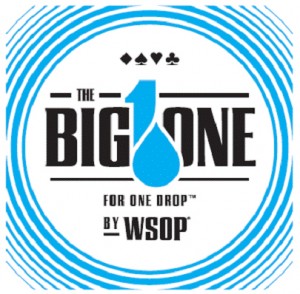 The Big One for One Drop is a charity poker tournament that is being introduced for the 2012 World Series of Poker and will feature the largest buy-in in poker tournament history, a cool $1,000,000.
The Big One for One Drop is a charity poker tournament that is being introduced for the 2012 World Series of Poker and will feature the largest buy-in in poker tournament history, a cool $1,000,000.
The tournament is the brain-child of Cirque du Soleil founder, poker player, and philanthropist Guy Laliberte. The charitable aspect of the tourney will see 11.11% of the prize pool being donated to the One Drop foundation, a charity founded by Laliberte that strives to provide access to safe drinking water for all of the world’s people. There’s no doubt that all of the buzz around the Rio this year is about the The Big One for One Drop and with live streaming on ESPN it’s sure to be an event that goes down in the annals of poker history.
Entrants
The event is to be capped at 48 players and already more than 40 players have registered or confirmed their intention to play the tournament, including the likes of Patrik Antonius, Johnny Chan, Daniel Negreanu, Tom Dwan, Tony G, Elky, Jonathan Duhamel, Ben Lamb, Justin Smith, Andrew Robl, Jason Mericer and several people from outside the poker world including hedge fund managers and businessmen. Both Phil Hellmuth and Phil Ivey have not publicly stated that they will be playing the event yet.
Many players and poker fans have questioned why a cap is in place, and the WSOP have stated that it is there to prevent too much money in the poker economy flowing to just a few players. The argument against this is that very few players will be stumping up the whole million dollar buy-in themselves and that with pieces being bought and sold, the money will be re-distributed by those who cash. Despite calls to remove the cap, WSOP officials have re-iterated that the event will not see more than 48 competitors.
Structure
If you’re paying a million dollars to enter a poker tournament, you’re going to want some value for money, and you’re going to want to ensure that variance plays as small a part in the outcome as possible. The tournament organizers have done their best to make sure that’s the case, with each player starting with an astonishing 5,000 big blind stack. Each player will receive 3 million chips to begin with and the blinds will starts at 3,000-6,000 with a 1,000 ante and all tables will be 8-handed. The blind levels are an hour long and blind jumps are typically very small. Even at the end of day 1, a starting stack represents 75 big blinds. The event kicks off at 1:11 pm on Sunday July 1st, and is scheduled to run for 3 days. 9 levels are due to be played on day 1, and day 2 will see the remaining players fight it out for a spot at the final table.
The structure gives and amazing amount of play and leaves rooms for the best players in the world to get extremely creative and put players in situations that they’re not at all used to. How would you feel sitting with KK on an AAKK2 board when there’s been a 4- or 5-bet pre-flop and someone shoves for a couple of thousand big blinds on the river?!
Aside from the heads-up battle, the most exciting part of this one will be on the bubble; the largest bubble in tournament history where those that squeak through get around $2 million and the bubble boy gets nothing. We might even see the likes of the ultra-aggressive Tom Dwan slow down a little or even turn into an out-and-out nit when faced with that kind of risk-reward situation. One thing is for sure, they won’t stump up an entry to next year’s tourney to whoever bubbles!
Whoever wins the tournament will instantly be made number one on poker’s all time money list. If we subtract the 11.11% that goes to One Drop and assume the event sells out, the prize pool will be in excess of $42.5M and it’s likely that 6 players will be paid with the winner getting close to 50% of the prize or around $20M, putting the $12M Jamie Gold earned for winning the Main Event in 2012 firmly in the shade. All-in-all, one player will earn $20m for 30 hours’ work; an hourly rate would make even Bill Gates of Mark Zuckerberg jealous.

